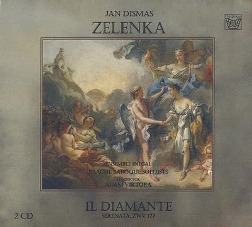Jan Dismas Zelenka – Il Diamante (Serenata ZWV 177) [2009]
Jan Dismas Zelenka – Il Diamante (Serenata ZWV 177) [2009]

CD 1
1 Sinfonia 7:09 (allegro - adagio - minuetto)
2 Recitativo 1:02 (Terra)
3 Aria 7:28 (Terra)
4 Recitativo 0:50 (Giunone)
5 Aria 12:54 (Giunone)
6 Recitativo 1:47 (Terra, Imeneo, Amore)
7 Aria 9:03 (Imeneo)
8 Recitativo 0:36 (Amore)
9 Aria 9:21 (Amore)
CD 2
0 Recitativo 0:51 (Giunone)
11 Aria 9:41 (Giunone)
12 Recitativo 1:19 (Imeneo, Amore)
13 Aria 9:40 (Amore)
14 Recitativo 0:50 (Terra)
15 Aria 6:00 (Terra)
16 Coro 3:11
17 Recitativo 1:45 (Venere)
18 Aria 10:33 (Venere)
19 Coro 3:14
Roberta Mameli - soprano (Giunone)
Marie Fajtova - soprano (Amore)
Gabriela Eibenova - soprano (Venere)
Hana Blazikova - soprano (Terra)
Kai Wessel - alto (Imeneo)
Ensemble Inégal
Prague Baroque Soloists
Adam Viktora – director
Although Zelenka is being slowly rediscovered, those who do have some familiarity with his music will for the most part see him as exclusively a sacred music composer. He did after all lose out in 1733 to Hasse for the post of Kapellmeister to the Dresden court, instead being appointed in 1735 to the lesser post of church composer (and which he subsequently lost to JSB the next year) specifically in charge of sacred music.
However for the occasion of the marriage of Prince Georg Ignatius Lubomirski to Baroness Joanna Stein in 1737, Zelenka was called upon to compose a serenata for the evening's entertainment. Normally this commission would have gone to Hasse, but he was apparently busy working on his opera "Senocrita". This gave Zelenka the opportunity to demonstrate his mastery of the Italianate secular vocal-instrumental form, one of only two surviving substantial vocal-instrumental secular pieces along with "Melodrama De Sancto Wenceslao".
The plot: The Earth presents a spectacular diamond to the goddess Juno, who decides, in her capacity as goddess of marriage, to use the gem as a gift for the marriage of Georg and Joanna, and summons Hymen, patron of marriage, to perform the task. Cupid brings the bridegroom, Juno bids Hymen to hand over the jewel to Georg to give to his betrothed, and Cupid and Hymen sing of the beauty of both the stone and the bride, and the unity of Germany and Poland brought about by the marriage. Earth asks Juno to bless the couple with fertility, whereupon the chorus invites all to celebrate the marriage.
And then, a surprise. A new character appears - Venus, who in her recitative and aria asks "Am I forgotten where love is being celebrated? Only I can make your happiness perfect", after which the chorus is repeated. The booklet speculates that the work originally ended with the first chorus and Venus is a late addition. Furthermore it hypothesises that, perhaps plausible as Hasse in fact conducted the performance of the work, his wife and superstar mezzo-soprano Faustina Bordoni sang the part of Venus and that this extra part was created to accommodate her.
With this work Zelenka proves himself as second to none in his mastery of the genre, and we should be truly thankful that this has survived - it almost beggars belief that these kind of works were created for a one-off performance, thence to usually be forgotten. There are eight gorgeous and very substantial arias here sung by a talented bunch of vocalists - soloists Roberta Mameli, Marie Fajtova, Gabriela Eibenova, Hana Blazikova, Kai Wessel, and the chorus of the Prague Baroque Soloists, as well as Zelenka's stirring and uplifting orchestration performed by Ensemble Inegal and directed by Adam Viktora. This has been getting almost daily spins (or whatever the equivalent terminology might be on an iPod) since purchase and I don't think there will be any chance that I will tire of this - it really is a dazzling and remarkable work, in a wonderful recording. ---E. L. Wisty, amazon.com
download: uploaded yandex 4shared mediafire solidfiles mega zalivalka filecloudio anonfiles oboom
Last Updated (Tuesday, 08 July 2014 22:04)








